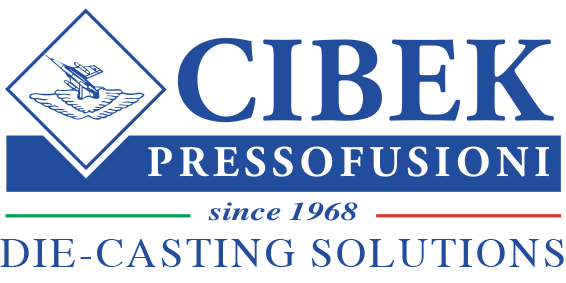COMPANY PROFILE AND PHILOSOPHY
La Cibek die casting
Since 1968, La Cibek die casting has been operating in the Aluminium and Zamak die casting sector with a growing commitment to the adoption of new technologies and production process controls: a commitment that translates into die casting quality.
Attentive, therefore, to the continuous technological evolution of the die-casting process, La Cibek die casting is today able to offer its customers competitive products that adhere to the quality standards required by the market.
Over the years, La Cibek die casting has acquired a particular specialization in the production of Aluminium and Zamak die castings, targeting the following areas: Industrial Automation, Professional Electrical Appliances, Electronic, Electrical, LPG-Methane supply systems for automobiles, Agricultural Machines, Industrial Cleaning Machines, Hydraulics, Pneumatics and Measuring Instruments.
Work philosophy and market approach
Our work philosophy originates from a fundamental assumption: close cooperation with the customer for the project development in a CO-DESIGN logic.
The design and simulation skills of filling and in-mould temperature analyses allow the reduction of critical casting areas. Subsequent accurate machining also allows the production of high-quality castings.
Starting from the study and adoption of all the technical expedients aimed at minimizing the machining required to realize the items we can often obtain a reduction of the manufacturing costs.
Within a short time frame, La Cibek die casting is able to respond to the most demanding enquiries with innovative solutions. Extreme organizational and production flexibility allow La Cibek to handle even small batches, with a minimum limit of 1,000 shots, at competitive prices.
Die-Casting Enterprise Network
A group of suppliers specialized in Aluminium and special alloy die-casting, guarantees a complete service: from the industrialization of the item, co-design and realization of the die-casting mould and trimming tool, including filling simulation with program CASTLE. Die casting with machines up to 650 tons, finishing and mechanical machining required by the customer complete the die process to produce goods ready to be assembled by the customer.
– DIE CASTING IN HISTORY –
Evolution of die casting
Die casting originated in the United States from an idea of Herman Doehler co-founder of Doehler-Jarvis who developed the first die casting machine. Yet in the United States, the world’s first Aluminium die-cast component in the world for commercial use was produced in 1915.
In 1938, Triulzi Company in Milan, by “copying the design” from an old “Polak“, designed and built the first horizontal machine suitable for Aluminium casting under pressure. This technology overcame the old casting concepts of that time, sand and shell mould casting.
The presses were initially not equipped with a toggle system or even with multiplication ‘forces’ using cylinders of inert gas (nitrogen), they used pumps to feed large cylinders with compressed water.
Over the years, many industries were founded all around Brescia, taking advantage of the technological evolution and the increasing efficiency in production with closed-cycle injection systems, effectively forming a die casting district with its beating core in Brescia.
PRODUCTION METHODS IN ITALY
Die-casting was initially called pressure die-casting. This is a foundry process where the molten metal, Aluminium or Zamak is injected under high pressure into a mould. This particular process was first used in the USA in the second half of the 19th century.
The mould used for die casting is actually composed of two half moulds, usually made of hardened steel. Due to this characteristic of the mould, it is only possible to melt materials that have their melting point at a lower temperature than that with which the mould was made.
The materials used in die casting are predominantly Aluminium and Zamak alloys. The pressure required to inject the metal is usually quite high and can range from 20 to 1500 bar. The pressure can be maintained for the entire duration of the die-casting process (until the metal solidifies).
Following the injection phase comes the mould cooling phase, which is carried out using a cooling liquid inside the mould via temperature control circuits.
At La Cibek die casting, the die-casting cycle is fully automated to guarantee high productivity.
HOT CHAMBER DIE-CASTING
Hot chamber die-casting is carried out using a furnace that allows better control of the casting temperature and higher productivity. With hot-chamber die-casting, the pressure required is lower than with cold-chamber and hardly exceeds 130/140 bar.
Hot chamber die casting is mainly used for Zinc alloys and allows a high-quality surface finish.
The cold chamber die-casting process has less control over the temperature and lower productivity as it requires more time in the injection phase.
Cold chamber die casting allows a wider choice of materials (Aluminium and Zinc alloys ) to be used and higher pressures (1500 bar) to be achieved.






